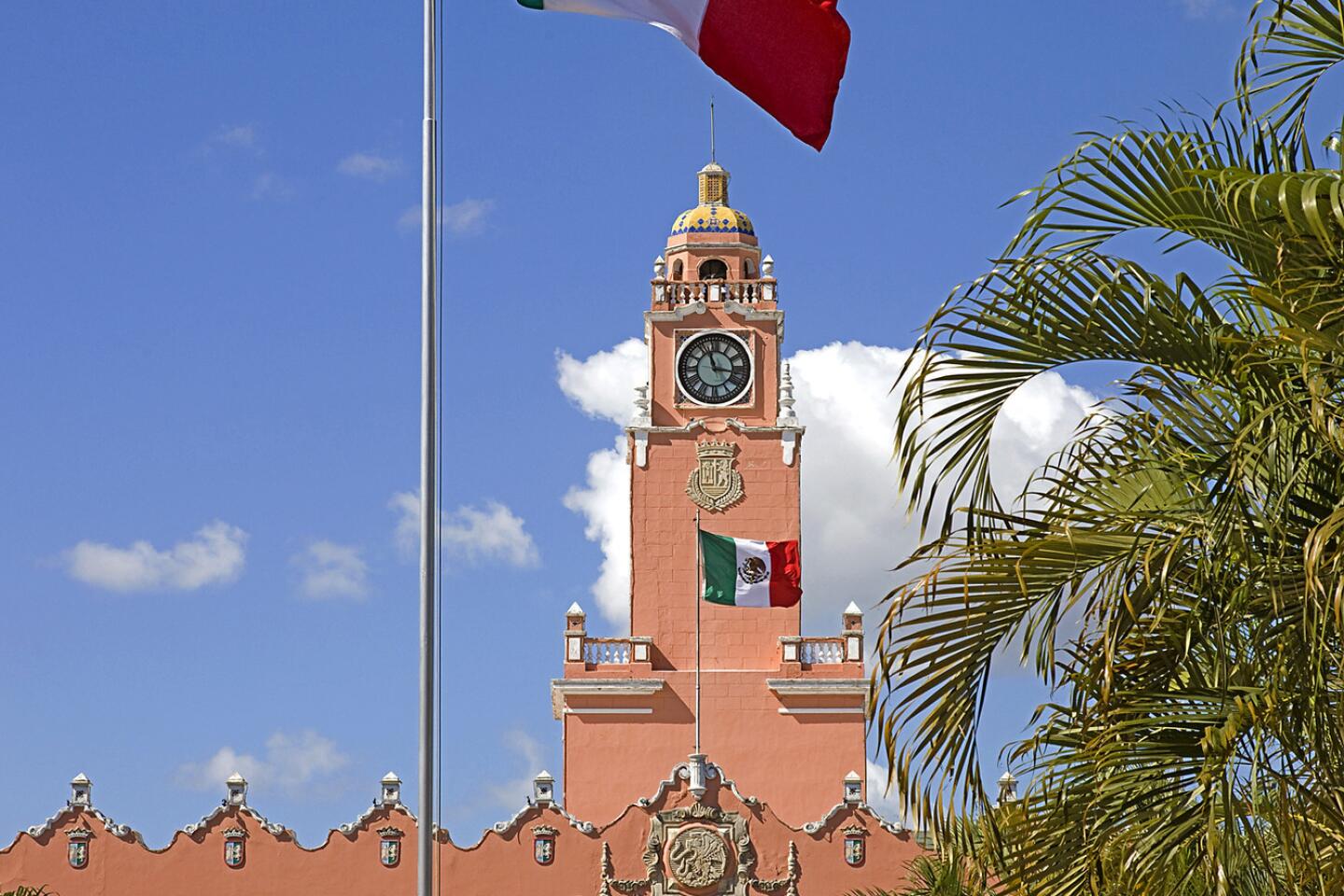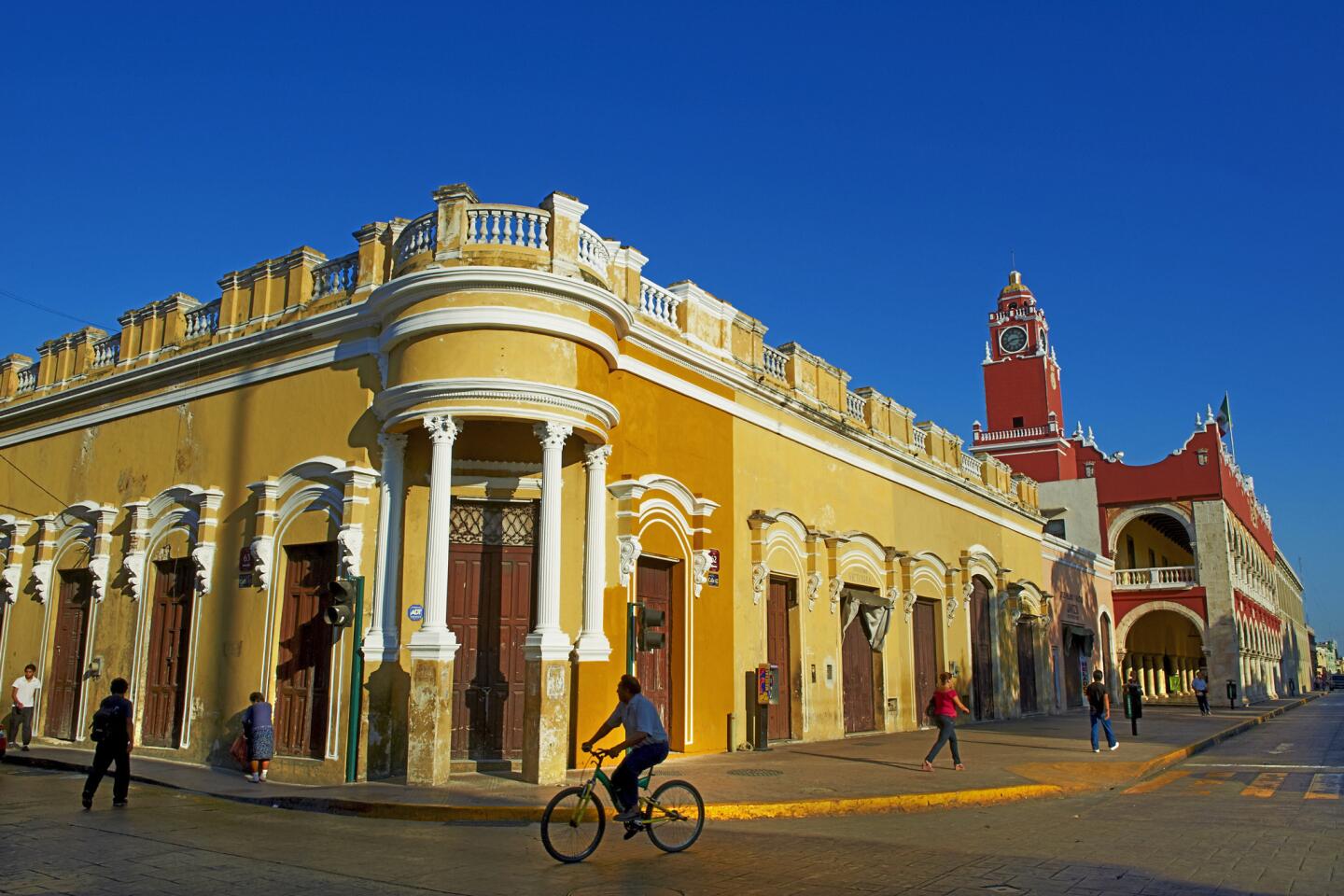Mérida — an appealing destination in Mexico’s south
- Share via
MÉRIDA, Mexico — Until this winter, Mérida had just been a busy city I passed through on my way to the ancient Mayan ruins.
Then, in mid-December, I made it my destination.
I pretty much had to: I’d been hearing the city’s name all fall, from house-hunting shows on TV to acquaintances in Minnesota trading tips about winter getaways. Even my new dog groomer turned out to be renovating a house here.
Was Mérida, the capital of Yucatán state, going to be Mexico’s next big Yankee magnet — a new Ajijic or San Miguel de Allende?
I needn’t have worried, though the city offers Americans many temptations: warm weather, cheap building stock, good healthcare, inexpensive insurance, property taxes a fraction of what they are at home, free cultural events and a trove of builders, woodworkers, blacksmiths and stone masons who do quality work for prices Americans can’t quite believe.
Mérida was particularly appealing on weekend nights when the narrow streets around its central plaza were closed to traffic, music flooded from the sidewalk cafes and people of all ages went strolling in the warm evening air. I went too.
Maya girls from Chiapas state were carrying armloads of embroidered shawls, hoping someone would buy them. Artists had watercolors and beaded jewelry spread out for sale. Food-cart vendors were making cheese roll-ups to go. And the drivers of Mérida’s romantic horse-drawn carriages, their white-painted rigs decorated with roses, were patiently waiting for fares.
I knew this was the crowded center of a city of a million people, but it felt as sweet and safe as a village in the countryside.
In all the evenings I spent walking there, nobody hassled me. Nobody hassled me by day, either, which gave me the rare joy of being a tourist without feeling like one.
This sense of safety wasn’t an illusion, and “it’s to Mérida’s credit,” said Brent Marsh, a New Zealander who leads house tours for visitors, including prospective home buyers, for the Mérida English Library. “People from farther north — Monterey and Mexico City — are moving their families here for safety.”
Geography plays a role in this: The Yucatàn Peninsula lies too far east to be on the drug-smuggling routes running north through central Mexico.
But then, the Yucatán has always stood apart from the rest of the country. The Spanish conquest took longer here, and bloody resistance flared up again in the mid-1800s. And until the 1950s, when good roads arrived, it was easier for people to get to Paris than to Mexico City.
In the 19th century, when Yucatecan landowners began to get rich raising “green gold” — henequén, a big, tough, agave-like plant that yields good fiber for rope — the only way they could get it out was by ship to Europe, which was where wealthy families sent their children to be educated.
When the ships returned, they carried ballast that changed Mérida’s architecture, said Keith Heitke, a former New Yorker who leads house tours for the English-language publication Yucatán Today.
Iron rails from European train lines replaced termite-vulnerable ceiling beams, French red tiles covered the roofs, and ceramic floor tiles took the place of carpets.
Isolation also helped the old culture survive. Today, more than 6 million people identify themselves as Mayan. Mayan dialects are widely spoken in the states of Campeche, Chiapas, Yucatán and Quintana Roo and southward into highland Guatemala and Belize.
Mérida’s centro historico is now one of the biggest historic districts in Latin America, and local government favors preserving old houses to protect the city’s authentic character. That alone might make locals look on the newcomers kindly, but they probably would anyway.
“The Yucatán people are very accepting,” said Evalynne Engle, who moved to Mérida from Nevada with her husband in 2006. “I mean, they accept us gringos.”
Local people also seem to appreciate those efforts to save the old houses, even though 20 years ago, “you couldn’t give these houses away,” Engle and other expatriates told me.
Younger people were tired of crumbling walls, termite infestations, peeling paint and balky plumbing. They moved out, and centro became, as one man put it, “the place where Grampa lived.”
Now, in the leafy neighborhoods to the north, there are suburban-style homes, high-rise hotels, multiplex theaters, car dealerships and familiar names: Starbucks, Home Depot, Wal-Mart.
But the old city core is still a tight network of one-story façades set shoulder-to-shoulder and flush to the sidewalk, street after street, block after block, neighborhood after neighborhood.
Except for their paint jobs — mostly pastels — all the old houses looked alike to me. There was no way to tell what they were like inside, and their simple architecture made the streets look alike too — walled and blank like rows of low fortresses.
Which is exactly what they were, Heitke said.
The best example is also the oldest: Casa de Montejo, which dominates one side of the central plaza. It was completed in 1549 for the family of the city’s founder, whose last descendant didn’t move out until 1978.
The floor plan derives from the Romans, Heitke said: The walls are too high for intruders to scale, and everything else is hidden inside. Repeat that pattern, and the result is a grid of long, narrow houses, each with a small front on the street and only one way in.
“Close those doors up,” he said, “and you’re very safe.”
Inside, the rooms become lower toward the back. That’s where the original kitchen would have been, the servants’ quarters, the toilet, the horses, dogs and chickens.
These days, that’s where new owners put the swimming pool.
Some of them are snowbirds; others are absentee landlords who live in the U.S., Europe or elsewhere in Mexico. But others are full-time residents — expats who have built new lives in Mérida.
John Prentice Powell, for example, a Texas-born interior designer, painter and former model, had worked in New York and Paris before he and his partner discovered Mérida 10 years ago on a two-month-long search through Mexico.
Since then, the men have renovated about a dozen houses, some for other owners, a few for themselves, and the city is home. “I don’t think I’ll ever go back,” Powell said.
Dave Thom, the Minneapolis dog groomer, first saw Mérida on a break from a beach vacation nearby. In 2005, he bought a 5,000-square-foot 19th-century house with original floor tiles and interior plasterwork and — not to be taken for granted here — working electricity, running water and a usable kitchen.
Thom has been renovating it ever since, supervising during his vacations from the States and trusting his workmen the rest of the time. The white-trimmed, salmon-pink façade was restored first, thanks to a city program that covers the cost of labor if the homeowner pays for materials.
The expats I met said they feel welcome in Mérida, not resented, as Americans often do in more Yankee-fied places. In this city, there are too few to make a dent: “I’ve heard 2,000 to 4,000,” Heitke said, though nobody knows for sure.
“Mérida’s not Americanized,” Engle said. “It’s more of an advantage to come here than to go to San Miguel. It’s still Mexico.”
On my last night in town — it happened to be Dec. 21, the day the 5,125-year-old Mayan calendar ended — I took a final stroll through the streets near the plaza grande. The regulars were there, but over the music from the cafes, I caught a weirder sound, high-pitched and quavering. An aggrieved soprano, maybe? Nope, just a white-haired guy in a straw hat, sitting on a box and running a home-made bow back and forth across the edge of an old-fashioned saw blade.
“My father teach me,” he said in English, guessing I spoke it. “I learn by ear — all by ear! I have 1,000 songs! Listen — ‘Casablanca’ song!” I gave him a few coins, and the whine of the musical saw followed me for a long time as I walked away. He was playing the old song that begins, “You must remember this...” By then, I was sure I would.
More to Read
Sign up for The Wild
We’ll help you find the best places to hike, bike and run, as well as the perfect silent spots for meditation and yoga.
You may occasionally receive promotional content from the Los Angeles Times.








